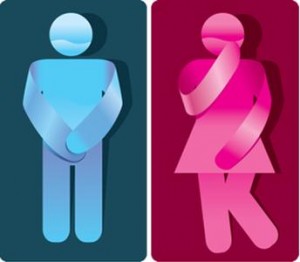
As a pelvic floor physical therapist, I am often asked this question by concerned women who may be experiencing pelvic organ prolapse (POP), a weakness disorder of the pelvic floor. POP is defined as “the descent of one or more of the anterior wall, posterior vaginal wall, the uterus (cervix) or the apex of the vagina (vaginal vault or cuff scar after hysterectomy)” by the International Continence Society.
There are several different types of POP, including:
- Uterine/cervix prolapse- when the uterus prolapses directly down through the vagina
- Cystocele/anterior prolapse- when the front vaginal wall is pushed down by the bladder
- Rectocele/posterior prolapse-when the back vaginal wall is pushed down by the rectum
- Rectal prolapse- when the rectal tissue prolapses through the anus. This is often related to chronic pushing and straining
Ordinarily, the pelvic floor organs are held in their upright position via intact endopelvic fascia and suspensory ligaments, especially the uterosacral ligament. Furthermore, the hammock-like levator ani (deep pelvic floor) muscles rest below the organs and prevent them from descending. Similar to postural muscles, the levator ani muscles provide continuous dynamic support to the pelvic floor, and they contract prior to movement to support the organs during movement. The ligaments serve as primary support from above and the pelvic floor muscles serve as backup support from below.
Many factors contribute to POP development. One such cause is pregnancy and childbirth. In fact, after an individual’s third vaginal delivery, the relative risk for POP development increases significantly. This risk rises even higher if instruments (forceps or vacuum) were used during delivery. Even those who have underwent C-section delivery are not necessarily in the clear either. Pregnancy alone even without vaginal delivery increases the risk of developing POP. This is due to the loosening effects created by the hormone relaxin which circulates in the blood at increased levels during pregnancy.
Other factors that contribute to POP development include chronic straining (ex. history of constipation), activities involving increased intra-abdominal pressure (ex. jobs that involve heavy lifting), obesity (which increases POP risk 30-50%), lower abdominal surgeries (which may disrupt the ligaments which provide support to the organs), aging, race (POP is seen more frequently in Hispanic women and less in Black/African American), and genetics.
POP severity is graded on a scale from zero (no prolapse) to four (the organ has completely extruded from the body, which is rare and requires surgery). Approximately 50% of women who have given birth experience POP at some point during their lives, and it is one of the leading reasons for women to undergo hysterectomy. In fact, 11.1% of community dwelling women undergo POP or incontinence surgery, however physical therapists are aiming to decrease these numbers through education about conservative treatment.
To Be Continued…



